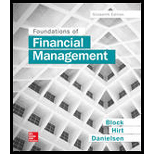
To explain:Â The impact of the risk-averse nature of corporate managers on their risk-taking ability.
Introduction:
Risk-aversion:
Risk-aversion is a behavioural response to uncertainty with the willingness to lower or avoid the risk associated with future decisions. The risk-aversive nature of a manager indicates the preference of stability over volatility.
Answer to Problem 1DQ
The statement that the risk-averse nature of corporate managers implies that they will not take any risk is not completely true. Risk-averse managers will tend to stay away from risk and associate themselves with stability but will also assume risk if such decisions provide higher returns to them.
Explanation of Solution
Risk is a fundamental phenomenon associated with every decision in the business world. No decision can remain risk-free but risk-averse managers tend to lessen it. However, this does not mean that corporate managers are completely reluctant to assume any risk. Corporate managers will take risk provided that the decision results in higher returns. There surely must be some additional benefit or compensation to assume risk to entice risk-averse managers.
Want to see more full solutions like this?
Chapter 13 Solutions
Foundations of Financial Management
- 1. How would you suggest the standard-setter or the regulator mitigate the potensial decrease in the quality of corporate reportingarrow_forwardExplain why Fannie Mae and Freddie Mac are an example of moral hazard and based on that critically discuss why financial markets should be regulated.arrow_forward05-Corporate governance mainly helps in reducing operational cost and at the same time increasing revenue so that a positive impact can be seen in the capital market in terms of share price. Apart from that which one of the following is NOT a benefit of good corporate governance? a. It also provides a close eye on risks, frauds and mismanagement b. It maintains investors confidence c. All of the options d. It doesn't provide any inducement / incentive to the shareholders or managers for their workarrow_forward
- What kind of financial risk caused the SVB crisis, what could be done to deal with it and what could they have done to avoid it?arrow_forwardIt is an axiom that may be characterized by managers making decisions that conflict with the best interest of the shareholders. a. the risk-return trade-off b. the agency problems c. the curse of competitive markets d. stockholders versus managersarrow_forwardWhat are some factors that can increase the risk that a corporation does not have a corporate culture that supports ethical decision making? Please explain.arrow_forward
- 46. Which of the following situations are likely to reduce agency conflicts between stockholders and managers? Group of answer choices a. Paying managers large fixed salaries. b. Enacting laws that increase the likelihood of corporate takeovers. c. Placing restrictive covenants in debt agreements like avoiding risky projects. d. All of the statements are correct. e. Two of the statements are correct.arrow_forward1. Do you think that financial managers should be held to a higher standard of ethical behavior? 2. In the video on ethics and my article from the Conway Daily Sun, there were several examples of unethical behavior, Please discuss a real life example of unethical behavior either from your personal experience or from the news. What do you think can be done to change the unethical behavior, or do you think it can't be stopped?arrow_forwardDiscuss how the free-rider problem aggravates adverse selection and moral hazard problems in financial markets.arrow_forward
- 11. How does a financial institution differ from an industrial corporation in terms of the management of risk?arrow_forwardp12 According to the pecking order theory, managers are less likely to use which of the following sources of financing? Retained earnings New preferred stock New common stock New debtarrow_forward5) A company's stock price jumped when it announced that its revenue had decreased because of the quality issues of its products. This is an example of ________.A) market riskB) unsystematic riskC) systematic riskD) undiversifiable riskarrow_forward
 Auditing: A Risk Based-Approach (MindTap Course L...AccountingISBN:9781337619455Author:Karla M Johnstone, Audrey A. Gramling, Larry E. RittenbergPublisher:Cengage LearningBusiness/Professional Ethics Directors/Executives...AccountingISBN:9781337485913Author:BROOKSPublisher:Cengage
Auditing: A Risk Based-Approach (MindTap Course L...AccountingISBN:9781337619455Author:Karla M Johnstone, Audrey A. Gramling, Larry E. RittenbergPublisher:Cengage LearningBusiness/Professional Ethics Directors/Executives...AccountingISBN:9781337485913Author:BROOKSPublisher:Cengage Intermediate Financial Management (MindTap Course...FinanceISBN:9781337395083Author:Eugene F. Brigham, Phillip R. DavesPublisher:Cengage Learning
Intermediate Financial Management (MindTap Course...FinanceISBN:9781337395083Author:Eugene F. Brigham, Phillip R. DavesPublisher:Cengage Learning



